Human Resource Management.
VerifiedAdded on 2023/02/02
|14
|3815
|90
AI Summary
Contribute Materials
Your contribution can guide someone’s learning journey. Share your
documents today.
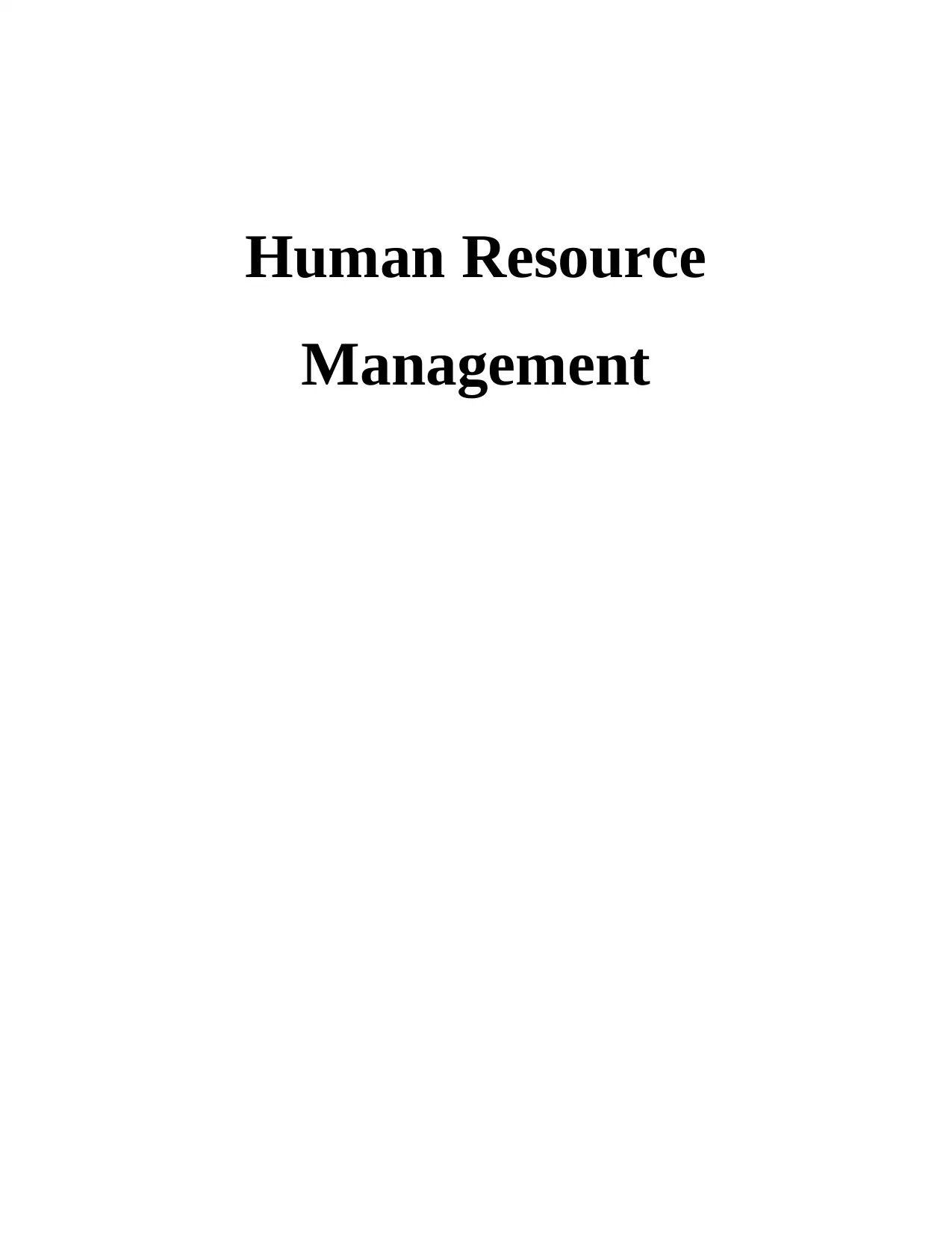
Human Resource
Management
Management
Secure Best Marks with AI Grader
Need help grading? Try our AI Grader for instant feedback on your assignments.
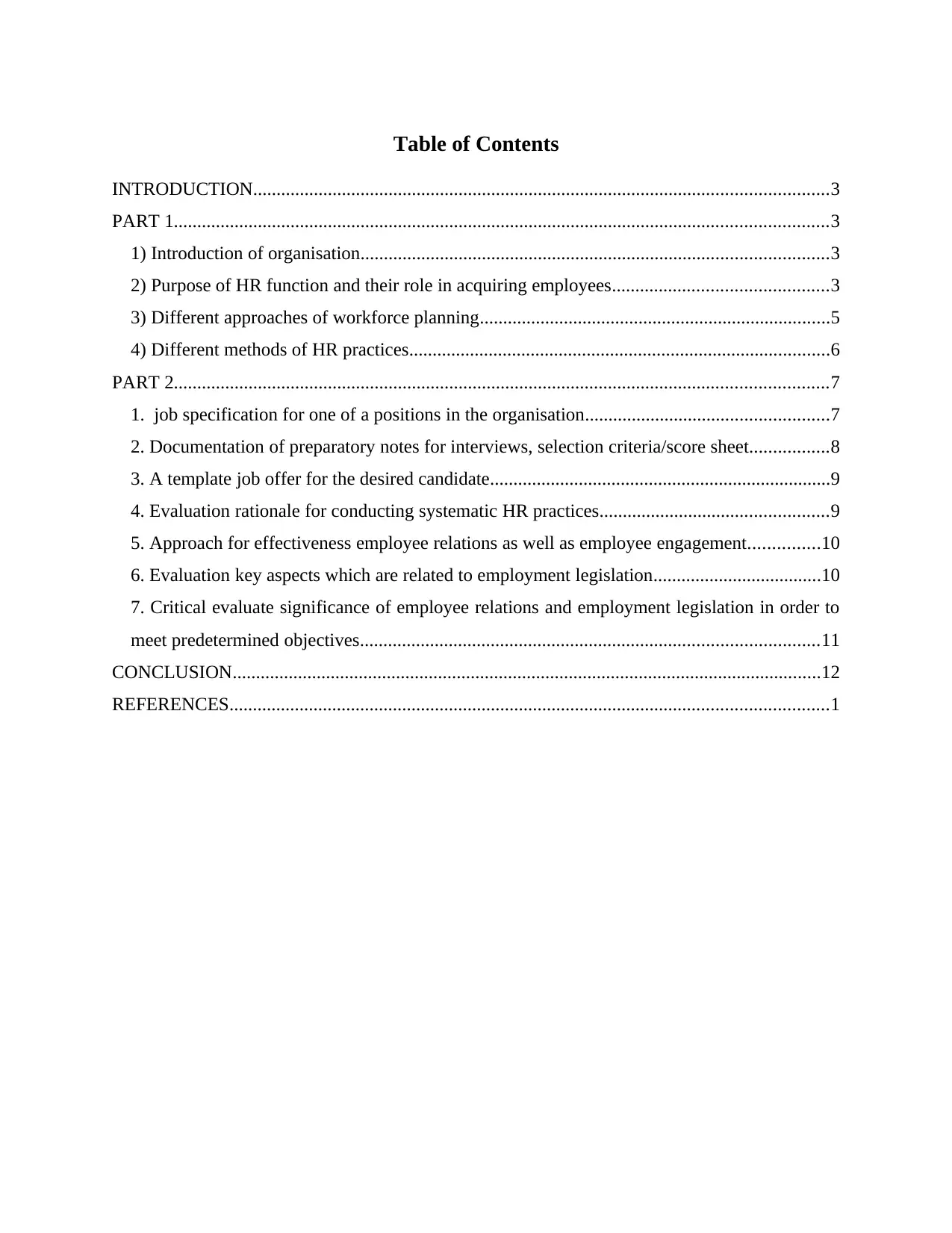
Table of Contents
INTRODUCTION...........................................................................................................................3
PART 1............................................................................................................................................3
1) Introduction of organisation....................................................................................................3
2) Purpose of HR function and their role in acquiring employees..............................................3
3) Different approaches of workforce planning...........................................................................5
4) Different methods of HR practices..........................................................................................6
PART 2............................................................................................................................................7
1. job specification for one of a positions in the organisation....................................................7
2. Documentation of preparatory notes for interviews, selection criteria/score sheet.................8
3. A template job offer for the desired candidate.........................................................................9
4. Evaluation rationale for conducting systematic HR practices.................................................9
5. Approach for effectiveness employee relations as well as employee engagement...............10
6. Evaluation key aspects which are related to employment legislation....................................10
7. Critical evaluate significance of employee relations and employment legislation in order to
meet predetermined objectives..................................................................................................11
CONCLUSION..............................................................................................................................12
REFERENCES................................................................................................................................1
INTRODUCTION...........................................................................................................................3
PART 1............................................................................................................................................3
1) Introduction of organisation....................................................................................................3
2) Purpose of HR function and their role in acquiring employees..............................................3
3) Different approaches of workforce planning...........................................................................5
4) Different methods of HR practices..........................................................................................6
PART 2............................................................................................................................................7
1. job specification for one of a positions in the organisation....................................................7
2. Documentation of preparatory notes for interviews, selection criteria/score sheet.................8
3. A template job offer for the desired candidate.........................................................................9
4. Evaluation rationale for conducting systematic HR practices.................................................9
5. Approach for effectiveness employee relations as well as employee engagement...............10
6. Evaluation key aspects which are related to employment legislation....................................10
7. Critical evaluate significance of employee relations and employment legislation in order to
meet predetermined objectives..................................................................................................11
CONCLUSION..............................................................................................................................12
REFERENCES................................................................................................................................1
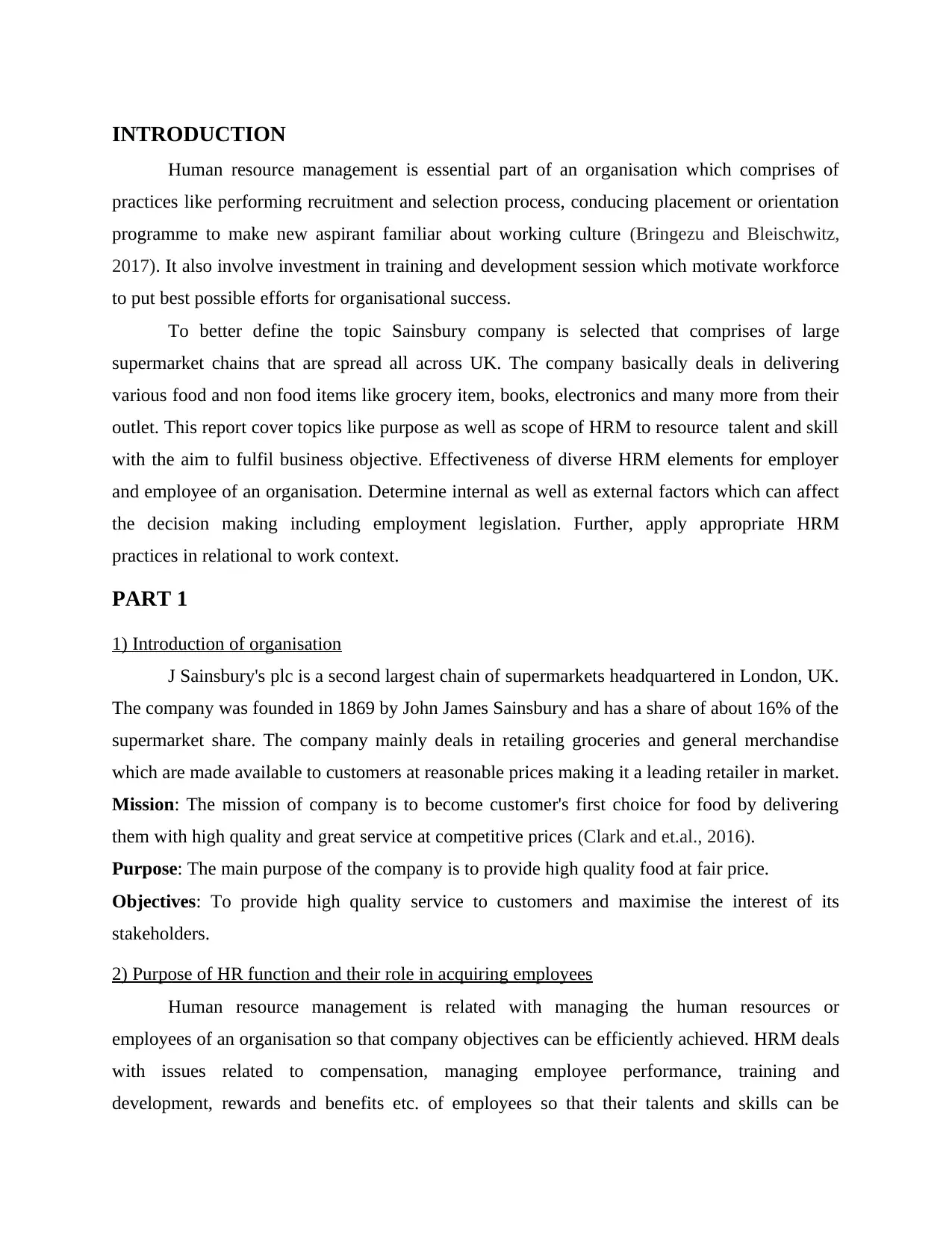
INTRODUCTION
Human resource management is essential part of an organisation which comprises of
practices like performing recruitment and selection process, conducing placement or orientation
programme to make new aspirant familiar about working culture (Bringezu and Bleischwitz,
2017). It also involve investment in training and development session which motivate workforce
to put best possible efforts for organisational success.
To better define the topic Sainsbury company is selected that comprises of large
supermarket chains that are spread all across UK. The company basically deals in delivering
various food and non food items like grocery item, books, electronics and many more from their
outlet. This report cover topics like purpose as well as scope of HRM to resource talent and skill
with the aim to fulfil business objective. Effectiveness of diverse HRM elements for employer
and employee of an organisation. Determine internal as well as external factors which can affect
the decision making including employment legislation. Further, apply appropriate HRM
practices in relational to work context.
PART 1
1) Introduction of organisation
J Sainsbury's plc is a second largest chain of supermarkets headquartered in London, UK.
The company was founded in 1869 by John James Sainsbury and has a share of about 16% of the
supermarket share. The company mainly deals in retailing groceries and general merchandise
which are made available to customers at reasonable prices making it a leading retailer in market.
Mission: The mission of company is to become customer's first choice for food by delivering
them with high quality and great service at competitive prices (Clark and et.al., 2016).
Purpose: The main purpose of the company is to provide high quality food at fair price.
Objectives: To provide high quality service to customers and maximise the interest of its
stakeholders.
2) Purpose of HR function and their role in acquiring employees
Human resource management is related with managing the human resources or
employees of an organisation so that company objectives can be efficiently achieved. HRM deals
with issues related to compensation, managing employee performance, training and
development, rewards and benefits etc. of employees so that their talents and skills can be
Human resource management is essential part of an organisation which comprises of
practices like performing recruitment and selection process, conducing placement or orientation
programme to make new aspirant familiar about working culture (Bringezu and Bleischwitz,
2017). It also involve investment in training and development session which motivate workforce
to put best possible efforts for organisational success.
To better define the topic Sainsbury company is selected that comprises of large
supermarket chains that are spread all across UK. The company basically deals in delivering
various food and non food items like grocery item, books, electronics and many more from their
outlet. This report cover topics like purpose as well as scope of HRM to resource talent and skill
with the aim to fulfil business objective. Effectiveness of diverse HRM elements for employer
and employee of an organisation. Determine internal as well as external factors which can affect
the decision making including employment legislation. Further, apply appropriate HRM
practices in relational to work context.
PART 1
1) Introduction of organisation
J Sainsbury's plc is a second largest chain of supermarkets headquartered in London, UK.
The company was founded in 1869 by John James Sainsbury and has a share of about 16% of the
supermarket share. The company mainly deals in retailing groceries and general merchandise
which are made available to customers at reasonable prices making it a leading retailer in market.
Mission: The mission of company is to become customer's first choice for food by delivering
them with high quality and great service at competitive prices (Clark and et.al., 2016).
Purpose: The main purpose of the company is to provide high quality food at fair price.
Objectives: To provide high quality service to customers and maximise the interest of its
stakeholders.
2) Purpose of HR function and their role in acquiring employees
Human resource management is related with managing the human resources or
employees of an organisation so that company objectives can be efficiently achieved. HRM deals
with issues related to compensation, managing employee performance, training and
development, rewards and benefits etc. of employees so that their talents and skills can be

utilised in achieving company goals. HRM also help in planning, recruitment, selection,
delegation of work, managing work culture etc. so that work can be completed on time.
Purpose of HRM
The purpose of HRM in a company is to manage employees relations which can help in
building an effective work culture so that company goals are achieved in an efficient manner.
Staffing, compensation, rewarding etc. are the functions of HRM which help in maximising the
productivity of employees which can help in improving their work efficiency and performance. It
is also important to recruit and select right kind of employees, at right time and for right job
vacancy sop that their work can be integrated with organisational goals (Cleaver, 2017).
Functions of HRM Planning: It is important that the number and type of employees which are needed to
achieve the goals of Sainsbury are determined and planned effectively by analysing
current and future needs of company. Organising: It is important that the task which are delegated to employees are well
organised which help in increasing their work efficiency. HRM of Sainsbury delegates
task to employees based on their skills and capabilities so that maximum potential can be
utilised. Recruitment: It is important to select right number and type of candidates from a pool of
candidates so that company can achieve its goals efficiently and work can be completed
on time.
Performance appraisal: It is important that the performance of employees is well tracked
so that they can be compensated accordingly based on their performance which help in
boosting the confidence of employees and motivating them (Jensen, 2017).
HR function play an important role in acquiring talented and skilled employees in
Sainsbury which can help in achieving company goals on time by filling up the job vacancies
that are available in the company. There are various key roles and responsibilities of HRM so
that better relations can be maintained with employees and their performance can be maximised
along with increasing their productivity. Some of the important roles and responsibilities of HR
in Sainsbury are: Maintaining employee relations: HRM plays an important role in maintaining good
relations with employee by increasing employee engagement so that employees can be
delegation of work, managing work culture etc. so that work can be completed on time.
Purpose of HRM
The purpose of HRM in a company is to manage employees relations which can help in
building an effective work culture so that company goals are achieved in an efficient manner.
Staffing, compensation, rewarding etc. are the functions of HRM which help in maximising the
productivity of employees which can help in improving their work efficiency and performance. It
is also important to recruit and select right kind of employees, at right time and for right job
vacancy sop that their work can be integrated with organisational goals (Cleaver, 2017).
Functions of HRM Planning: It is important that the number and type of employees which are needed to
achieve the goals of Sainsbury are determined and planned effectively by analysing
current and future needs of company. Organising: It is important that the task which are delegated to employees are well
organised which help in increasing their work efficiency. HRM of Sainsbury delegates
task to employees based on their skills and capabilities so that maximum potential can be
utilised. Recruitment: It is important to select right number and type of candidates from a pool of
candidates so that company can achieve its goals efficiently and work can be completed
on time.
Performance appraisal: It is important that the performance of employees is well tracked
so that they can be compensated accordingly based on their performance which help in
boosting the confidence of employees and motivating them (Jensen, 2017).
HR function play an important role in acquiring talented and skilled employees in
Sainsbury which can help in achieving company goals on time by filling up the job vacancies
that are available in the company. There are various key roles and responsibilities of HRM so
that better relations can be maintained with employees and their performance can be maximised
along with increasing their productivity. Some of the important roles and responsibilities of HR
in Sainsbury are: Maintaining employee relations: HRM plays an important role in maintaining good
relations with employee by increasing employee engagement so that employees can be
Secure Best Marks with AI Grader
Need help grading? Try our AI Grader for instant feedback on your assignments.
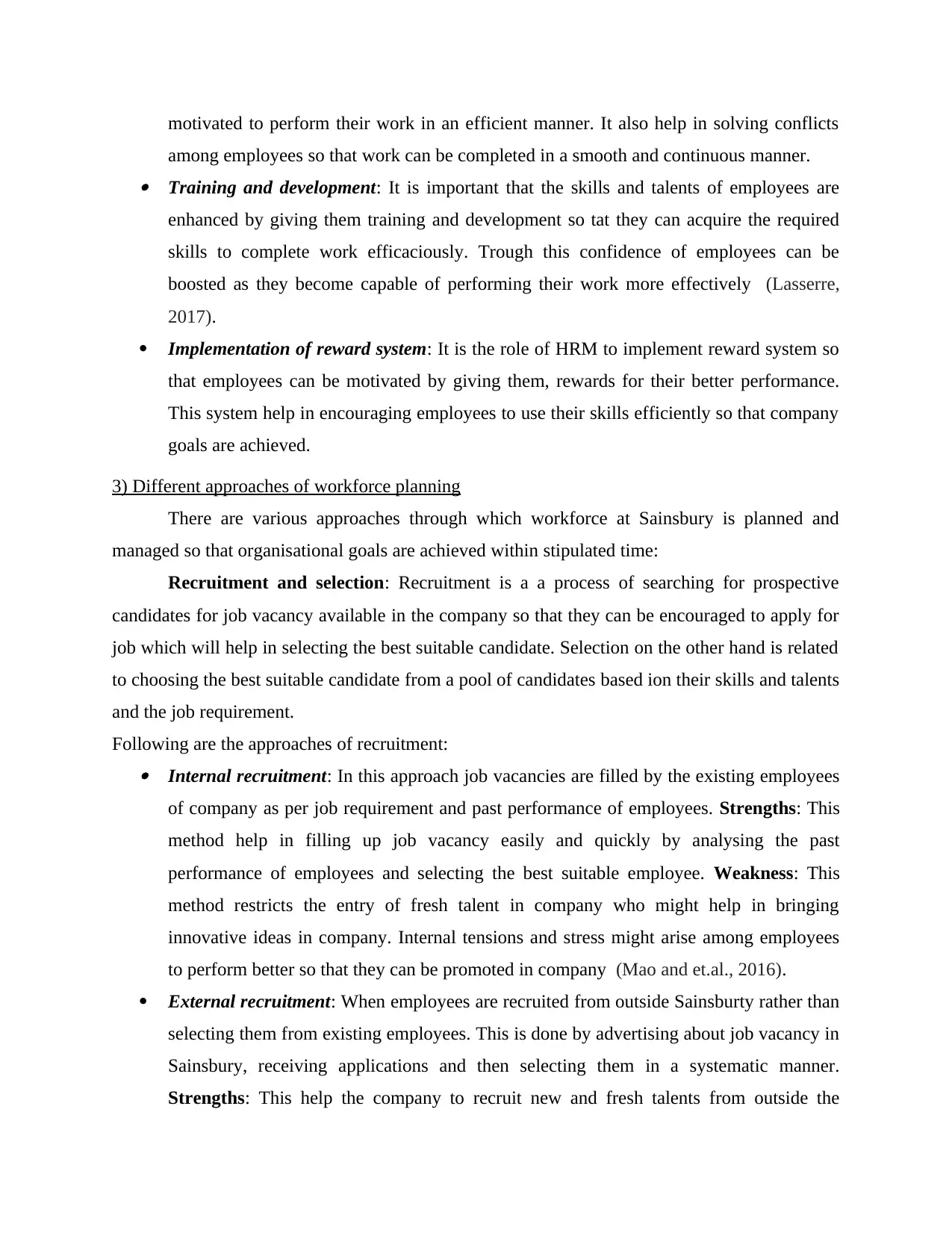
motivated to perform their work in an efficient manner. It also help in solving conflicts
among employees so that work can be completed in a smooth and continuous manner. Training and development: It is important that the skills and talents of employees are
enhanced by giving them training and development so tat they can acquire the required
skills to complete work efficaciously. Trough this confidence of employees can be
boosted as they become capable of performing their work more effectively (Lasserre,
2017).
Implementation of reward system: It is the role of HRM to implement reward system so
that employees can be motivated by giving them, rewards for their better performance.
This system help in encouraging employees to use their skills efficiently so that company
goals are achieved.
3) Different approaches of workforce planning
There are various approaches through which workforce at Sainsbury is planned and
managed so that organisational goals are achieved within stipulated time:
Recruitment and selection: Recruitment is a a process of searching for prospective
candidates for job vacancy available in the company so that they can be encouraged to apply for
job which will help in selecting the best suitable candidate. Selection on the other hand is related
to choosing the best suitable candidate from a pool of candidates based ion their skills and talents
and the job requirement.
Following are the approaches of recruitment: Internal recruitment: In this approach job vacancies are filled by the existing employees
of company as per job requirement and past performance of employees. Strengths: This
method help in filling up job vacancy easily and quickly by analysing the past
performance of employees and selecting the best suitable employee. Weakness: This
method restricts the entry of fresh talent in company who might help in bringing
innovative ideas in company. Internal tensions and stress might arise among employees
to perform better so that they can be promoted in company (Mao and et.al., 2016).
External recruitment: When employees are recruited from outside Sainsburty rather than
selecting them from existing employees. This is done by advertising about job vacancy in
Sainsbury, receiving applications and then selecting them in a systematic manner.
Strengths: This help the company to recruit new and fresh talents from outside the
among employees so that work can be completed in a smooth and continuous manner. Training and development: It is important that the skills and talents of employees are
enhanced by giving them training and development so tat they can acquire the required
skills to complete work efficaciously. Trough this confidence of employees can be
boosted as they become capable of performing their work more effectively (Lasserre,
2017).
Implementation of reward system: It is the role of HRM to implement reward system so
that employees can be motivated by giving them, rewards for their better performance.
This system help in encouraging employees to use their skills efficiently so that company
goals are achieved.
3) Different approaches of workforce planning
There are various approaches through which workforce at Sainsbury is planned and
managed so that organisational goals are achieved within stipulated time:
Recruitment and selection: Recruitment is a a process of searching for prospective
candidates for job vacancy available in the company so that they can be encouraged to apply for
job which will help in selecting the best suitable candidate. Selection on the other hand is related
to choosing the best suitable candidate from a pool of candidates based ion their skills and talents
and the job requirement.
Following are the approaches of recruitment: Internal recruitment: In this approach job vacancies are filled by the existing employees
of company as per job requirement and past performance of employees. Strengths: This
method help in filling up job vacancy easily and quickly by analysing the past
performance of employees and selecting the best suitable employee. Weakness: This
method restricts the entry of fresh talent in company who might help in bringing
innovative ideas in company. Internal tensions and stress might arise among employees
to perform better so that they can be promoted in company (Mao and et.al., 2016).
External recruitment: When employees are recruited from outside Sainsburty rather than
selecting them from existing employees. This is done by advertising about job vacancy in
Sainsbury, receiving applications and then selecting them in a systematic manner.
Strengths: This help the company to recruit new and fresh talents from outside the
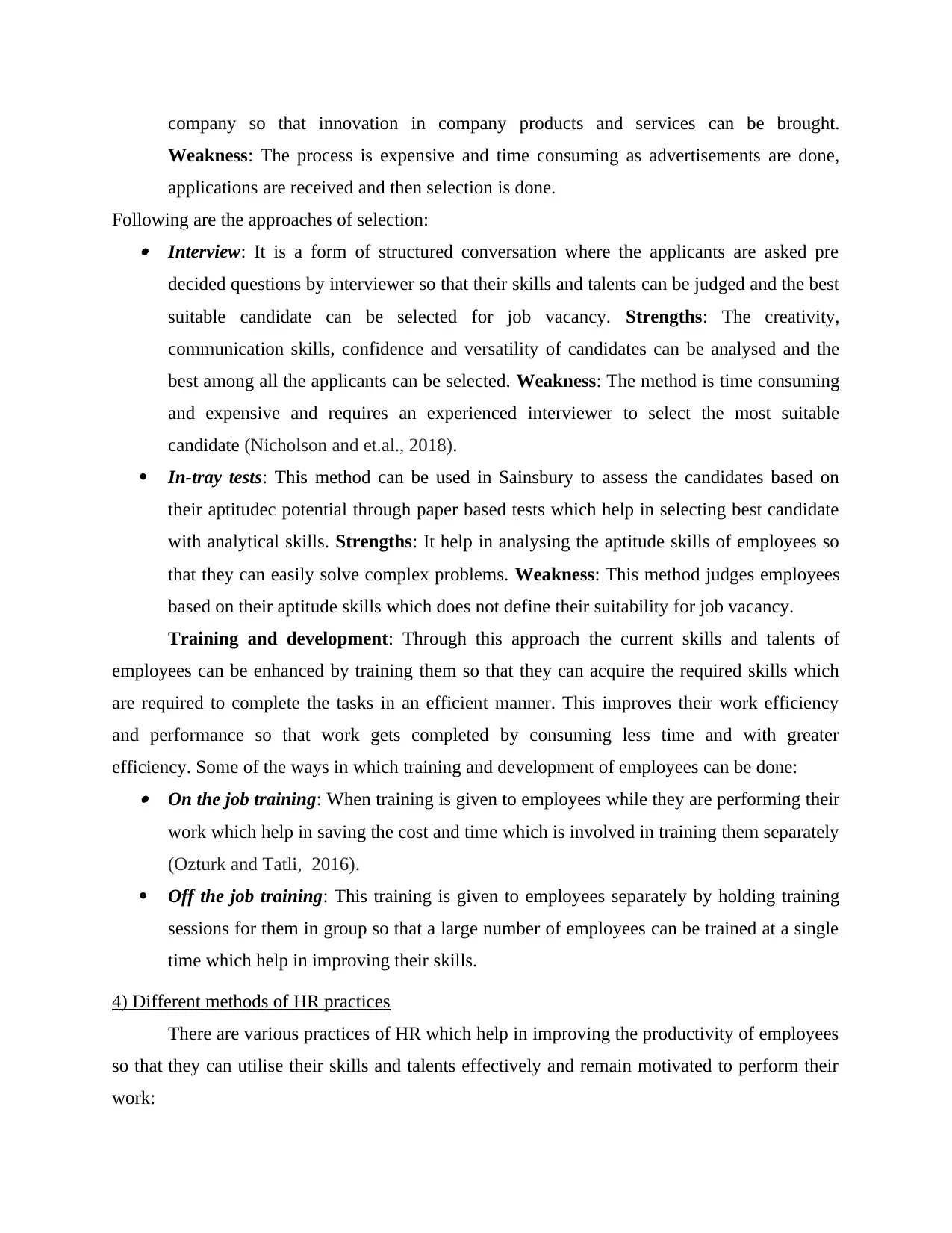
company so that innovation in company products and services can be brought.
Weakness: The process is expensive and time consuming as advertisements are done,
applications are received and then selection is done.
Following are the approaches of selection: Interview: It is a form of structured conversation where the applicants are asked pre
decided questions by interviewer so that their skills and talents can be judged and the best
suitable candidate can be selected for job vacancy. Strengths: The creativity,
communication skills, confidence and versatility of candidates can be analysed and the
best among all the applicants can be selected. Weakness: The method is time consuming
and expensive and requires an experienced interviewer to select the most suitable
candidate (Nicholson and et.al., 2018).
In-tray tests: This method can be used in Sainsbury to assess the candidates based on
their aptitudec potential through paper based tests which help in selecting best candidate
with analytical skills. Strengths: It help in analysing the aptitude skills of employees so
that they can easily solve complex problems. Weakness: This method judges employees
based on their aptitude skills which does not define their suitability for job vacancy.
Training and development: Through this approach the current skills and talents of
employees can be enhanced by training them so that they can acquire the required skills which
are required to complete the tasks in an efficient manner. This improves their work efficiency
and performance so that work gets completed by consuming less time and with greater
efficiency. Some of the ways in which training and development of employees can be done: On the job training: When training is given to employees while they are performing their
work which help in saving the cost and time which is involved in training them separately
(Ozturk and Tatli, 2016).
Off the job training: This training is given to employees separately by holding training
sessions for them in group so that a large number of employees can be trained at a single
time which help in improving their skills.
4) Different methods of HR practices
There are various practices of HR which help in improving the productivity of employees
so that they can utilise their skills and talents effectively and remain motivated to perform their
work:
Weakness: The process is expensive and time consuming as advertisements are done,
applications are received and then selection is done.
Following are the approaches of selection: Interview: It is a form of structured conversation where the applicants are asked pre
decided questions by interviewer so that their skills and talents can be judged and the best
suitable candidate can be selected for job vacancy. Strengths: The creativity,
communication skills, confidence and versatility of candidates can be analysed and the
best among all the applicants can be selected. Weakness: The method is time consuming
and expensive and requires an experienced interviewer to select the most suitable
candidate (Nicholson and et.al., 2018).
In-tray tests: This method can be used in Sainsbury to assess the candidates based on
their aptitudec potential through paper based tests which help in selecting best candidate
with analytical skills. Strengths: It help in analysing the aptitude skills of employees so
that they can easily solve complex problems. Weakness: This method judges employees
based on their aptitude skills which does not define their suitability for job vacancy.
Training and development: Through this approach the current skills and talents of
employees can be enhanced by training them so that they can acquire the required skills which
are required to complete the tasks in an efficient manner. This improves their work efficiency
and performance so that work gets completed by consuming less time and with greater
efficiency. Some of the ways in which training and development of employees can be done: On the job training: When training is given to employees while they are performing their
work which help in saving the cost and time which is involved in training them separately
(Ozturk and Tatli, 2016).
Off the job training: This training is given to employees separately by holding training
sessions for them in group so that a large number of employees can be trained at a single
time which help in improving their skills.
4) Different methods of HR practices
There are various practices of HR which help in improving the productivity of employees
so that they can utilise their skills and talents effectively and remain motivated to perform their
work:
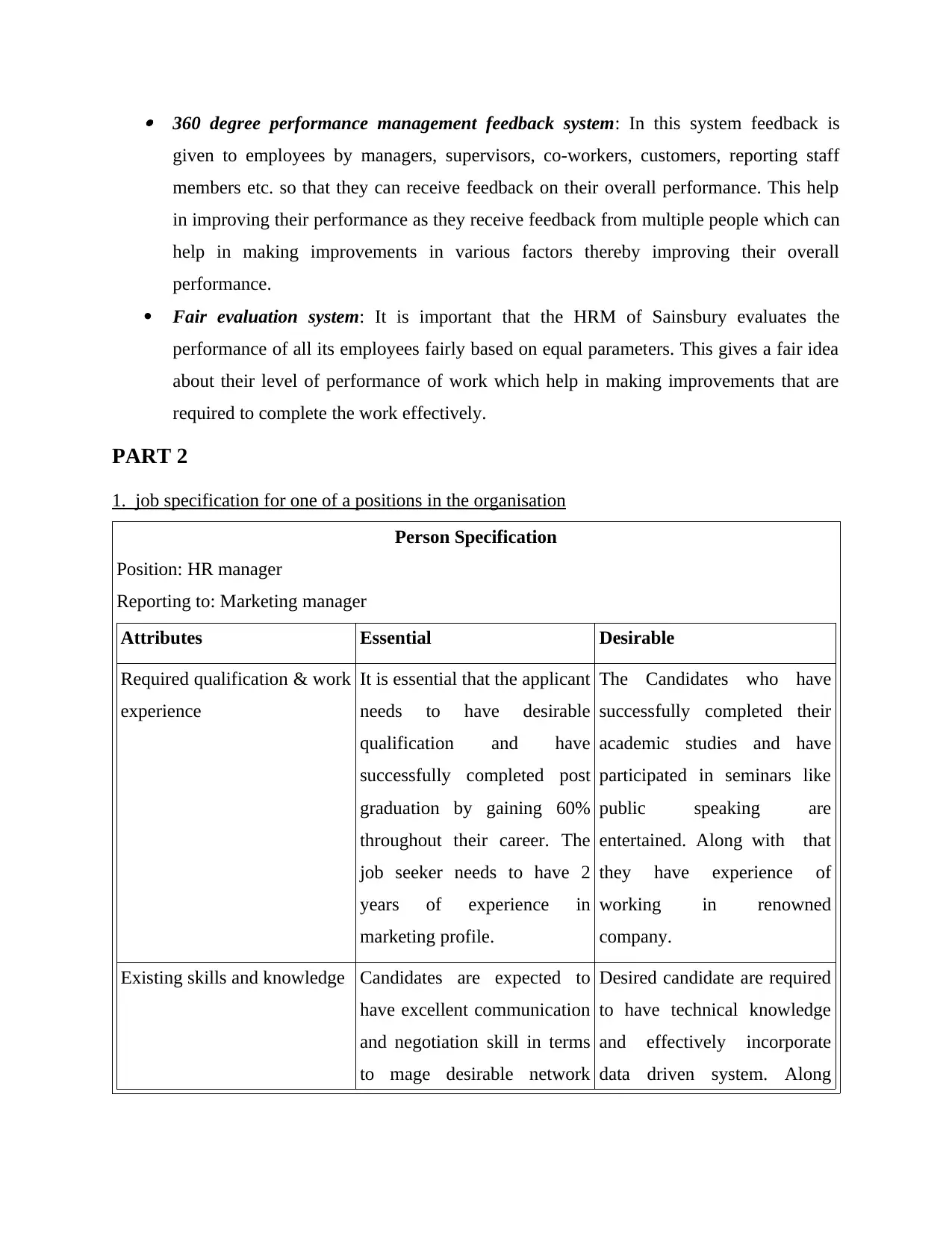
360 degree performance management feedback system: In this system feedback is
given to employees by managers, supervisors, co-workers, customers, reporting staff
members etc. so that they can receive feedback on their overall performance. This help
in improving their performance as they receive feedback from multiple people which can
help in making improvements in various factors thereby improving their overall
performance.
Fair evaluation system: It is important that the HRM of Sainsbury evaluates the
performance of all its employees fairly based on equal parameters. This gives a fair idea
about their level of performance of work which help in making improvements that are
required to complete the work effectively.
PART 2
1. job specification for one of a positions in the organisation
Person Specification
Position: HR manager
Reporting to: Marketing manager
Attributes Essential Desirable
Required qualification & work
experience
It is essential that the applicant
needs to have desirable
qualification and have
successfully completed post
graduation by gaining 60%
throughout their career. The
job seeker needs to have 2
years of experience in
marketing profile.
The Candidates who have
successfully completed their
academic studies and have
participated in seminars like
public speaking are
entertained. Along with that
they have experience of
working in renowned
company.
Existing skills and knowledge Candidates are expected to
have excellent communication
and negotiation skill in terms
to mage desirable network
Desired candidate are required
to have technical knowledge
and effectively incorporate
data driven system. Along
given to employees by managers, supervisors, co-workers, customers, reporting staff
members etc. so that they can receive feedback on their overall performance. This help
in improving their performance as they receive feedback from multiple people which can
help in making improvements in various factors thereby improving their overall
performance.
Fair evaluation system: It is important that the HRM of Sainsbury evaluates the
performance of all its employees fairly based on equal parameters. This gives a fair idea
about their level of performance of work which help in making improvements that are
required to complete the work effectively.
PART 2
1. job specification for one of a positions in the organisation
Person Specification
Position: HR manager
Reporting to: Marketing manager
Attributes Essential Desirable
Required qualification & work
experience
It is essential that the applicant
needs to have desirable
qualification and have
successfully completed post
graduation by gaining 60%
throughout their career. The
job seeker needs to have 2
years of experience in
marketing profile.
The Candidates who have
successfully completed their
academic studies and have
participated in seminars like
public speaking are
entertained. Along with that
they have experience of
working in renowned
company.
Existing skills and knowledge Candidates are expected to
have excellent communication
and negotiation skill in terms
to mage desirable network
Desired candidate are required
to have technical knowledge
and effectively incorporate
data driven system. Along
Paraphrase This Document
Need a fresh take? Get an instant paraphrase of this document with our AI Paraphraser
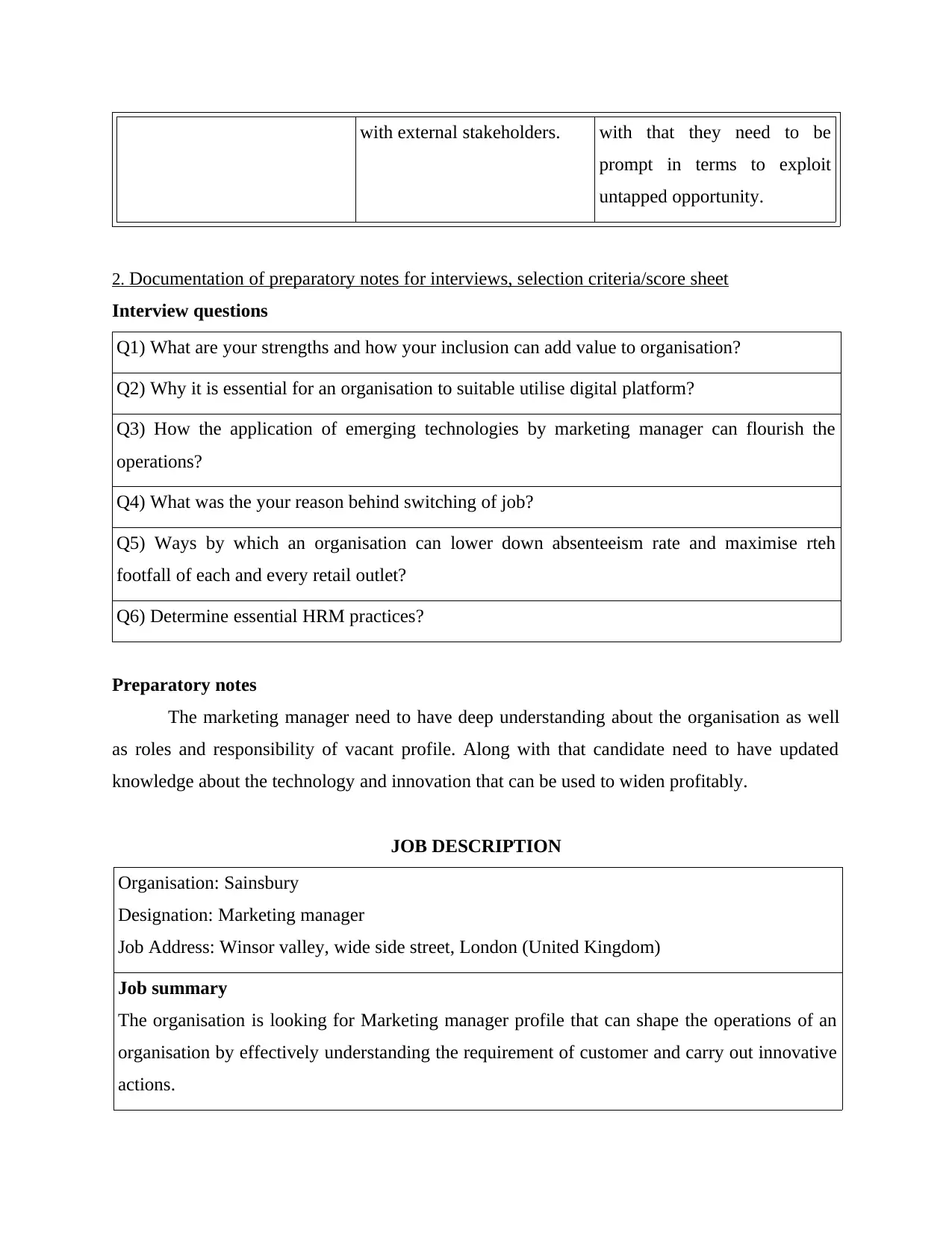
with external stakeholders. with that they need to be
prompt in terms to exploit
untapped opportunity.
2. Documentation of preparatory notes for interviews, selection criteria/score sheet
Interview questions
Q1) What are your strengths and how your inclusion can add value to organisation?
Q2) Why it is essential for an organisation to suitable utilise digital platform?
Q3) How the application of emerging technologies by marketing manager can flourish the
operations?
Q4) What was the your reason behind switching of job?
Q5) Ways by which an organisation can lower down absenteeism rate and maximise rteh
footfall of each and every retail outlet?
Q6) Determine essential HRM practices?
Preparatory notes
The marketing manager need to have deep understanding about the organisation as well
as roles and responsibility of vacant profile. Along with that candidate need to have updated
knowledge about the technology and innovation that can be used to widen profitably.
JOB DESCRIPTION
Organisation: Sainsbury
Designation: Marketing manager
Job Address: Winsor valley, wide side street, London (United Kingdom)
Job summary
The organisation is looking for Marketing manager profile that can shape the operations of an
organisation by effectively understanding the requirement of customer and carry out innovative
actions.
prompt in terms to exploit
untapped opportunity.
2. Documentation of preparatory notes for interviews, selection criteria/score sheet
Interview questions
Q1) What are your strengths and how your inclusion can add value to organisation?
Q2) Why it is essential for an organisation to suitable utilise digital platform?
Q3) How the application of emerging technologies by marketing manager can flourish the
operations?
Q4) What was the your reason behind switching of job?
Q5) Ways by which an organisation can lower down absenteeism rate and maximise rteh
footfall of each and every retail outlet?
Q6) Determine essential HRM practices?
Preparatory notes
The marketing manager need to have deep understanding about the organisation as well
as roles and responsibility of vacant profile. Along with that candidate need to have updated
knowledge about the technology and innovation that can be used to widen profitably.
JOB DESCRIPTION
Organisation: Sainsbury
Designation: Marketing manager
Job Address: Winsor valley, wide side street, London (United Kingdom)
Job summary
The organisation is looking for Marketing manager profile that can shape the operations of an
organisation by effectively understanding the requirement of customer and carry out innovative
actions.
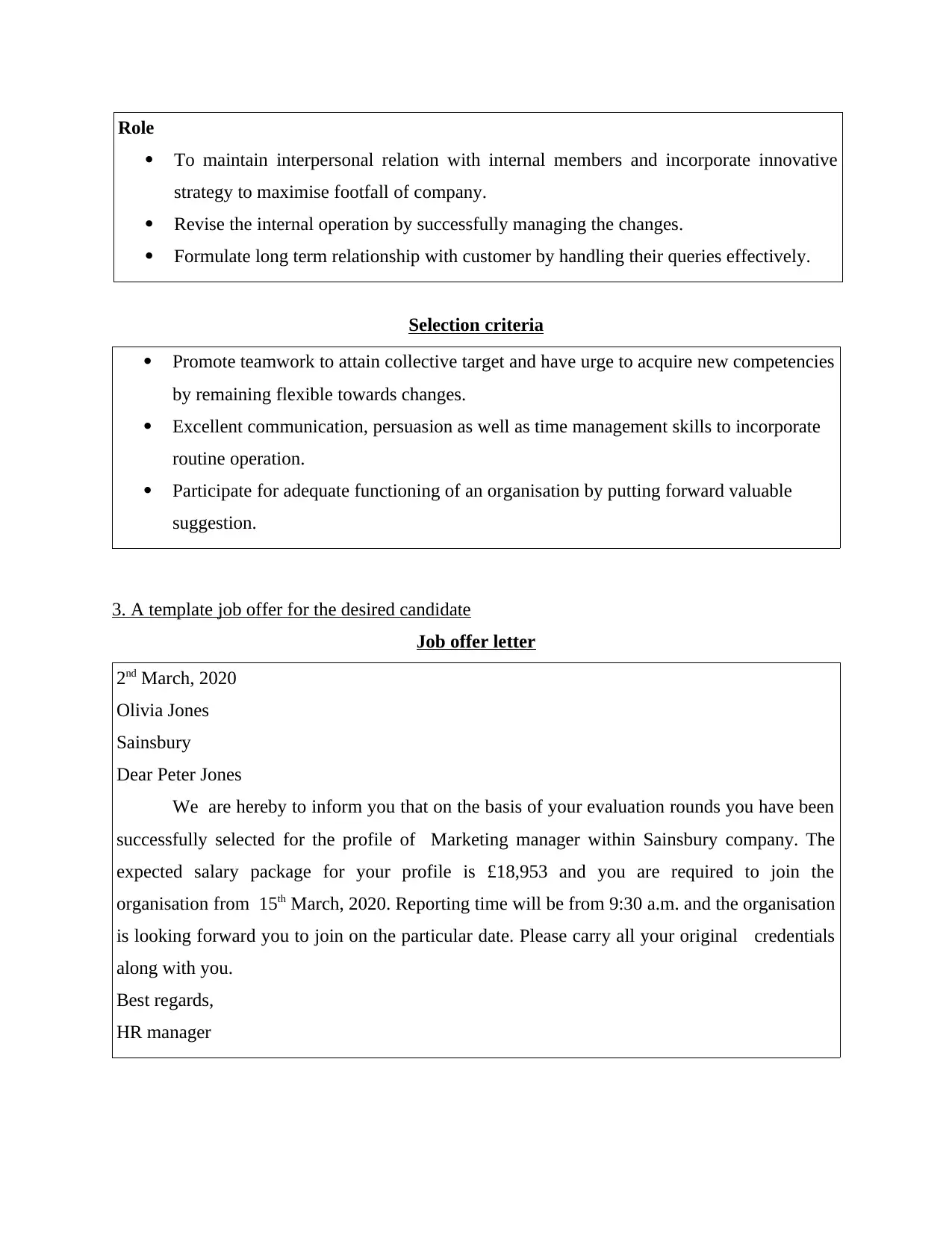
Role
To maintain interpersonal relation with internal members and incorporate innovative
strategy to maximise footfall of company.
Revise the internal operation by successfully managing the changes.
Formulate long term relationship with customer by handling their queries effectively.
Selection criteria
Promote teamwork to attain collective target and have urge to acquire new competencies
by remaining flexible towards changes.
Excellent communication, persuasion as well as time management skills to incorporate
routine operation.
Participate for adequate functioning of an organisation by putting forward valuable
suggestion.
3. A template job offer for the desired candidate
Job offer letter
2nd March, 2020
Olivia Jones
Sainsbury
Dear Peter Jones
We are hereby to inform you that on the basis of your evaluation rounds you have been
successfully selected for the profile of Marketing manager within Sainsbury company. The
expected salary package for your profile is £18,953 and you are required to join the
organisation from 15th March, 2020. Reporting time will be from 9:30 a.m. and the organisation
is looking forward you to join on the particular date. Please carry all your original credentials
along with you.
Best regards,
HR manager
To maintain interpersonal relation with internal members and incorporate innovative
strategy to maximise footfall of company.
Revise the internal operation by successfully managing the changes.
Formulate long term relationship with customer by handling their queries effectively.
Selection criteria
Promote teamwork to attain collective target and have urge to acquire new competencies
by remaining flexible towards changes.
Excellent communication, persuasion as well as time management skills to incorporate
routine operation.
Participate for adequate functioning of an organisation by putting forward valuable
suggestion.
3. A template job offer for the desired candidate
Job offer letter
2nd March, 2020
Olivia Jones
Sainsbury
Dear Peter Jones
We are hereby to inform you that on the basis of your evaluation rounds you have been
successfully selected for the profile of Marketing manager within Sainsbury company. The
expected salary package for your profile is £18,953 and you are required to join the
organisation from 15th March, 2020. Reporting time will be from 9:30 a.m. and the organisation
is looking forward you to join on the particular date. Please carry all your original credentials
along with you.
Best regards,
HR manager
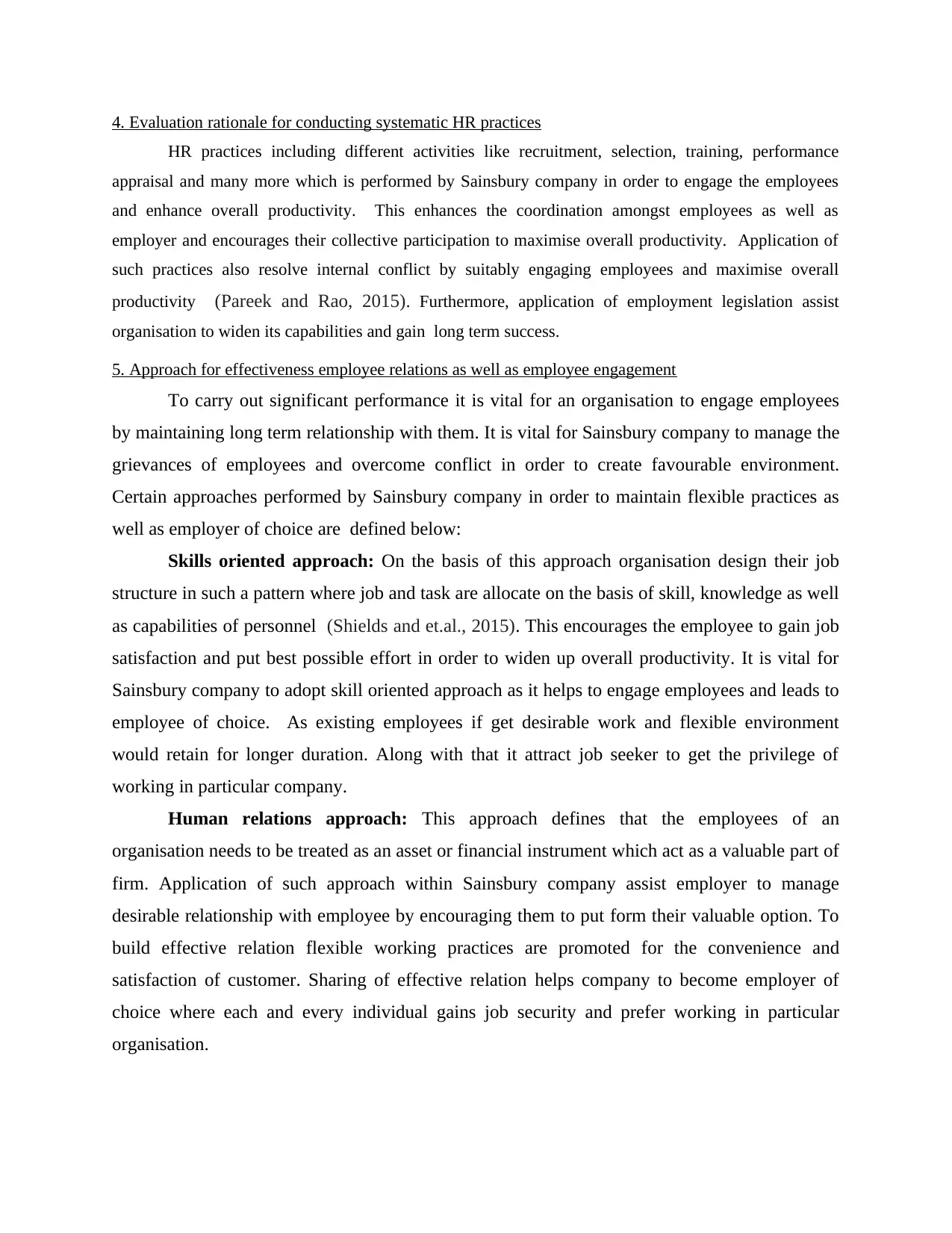
4. Evaluation rationale for conducting systematic HR practices
HR practices including different activities like recruitment, selection, training, performance
appraisal and many more which is performed by Sainsbury company in order to engage the employees
and enhance overall productivity. This enhances the coordination amongst employees as well as
employer and encourages their collective participation to maximise overall productivity. Application of
such practices also resolve internal conflict by suitably engaging employees and maximise overall
productivity (Pareek and Rao, 2015). Furthermore, application of employment legislation assist
organisation to widen its capabilities and gain long term success.
5. Approach for effectiveness employee relations as well as employee engagement
To carry out significant performance it is vital for an organisation to engage employees
by maintaining long term relationship with them. It is vital for Sainsbury company to manage the
grievances of employees and overcome conflict in order to create favourable environment.
Certain approaches performed by Sainsbury company in order to maintain flexible practices as
well as employer of choice are defined below:
Skills oriented approach: On the basis of this approach organisation design their job
structure in such a pattern where job and task are allocate on the basis of skill, knowledge as well
as capabilities of personnel (Shields and et.al., 2015). This encourages the employee to gain job
satisfaction and put best possible effort in order to widen up overall productivity. It is vital for
Sainsbury company to adopt skill oriented approach as it helps to engage employees and leads to
employee of choice. As existing employees if get desirable work and flexible environment
would retain for longer duration. Along with that it attract job seeker to get the privilege of
working in particular company.
Human relations approach: This approach defines that the employees of an
organisation needs to be treated as an asset or financial instrument which act as a valuable part of
firm. Application of such approach within Sainsbury company assist employer to manage
desirable relationship with employee by encouraging them to put form their valuable option. To
build effective relation flexible working practices are promoted for the convenience and
satisfaction of customer. Sharing of effective relation helps company to become employer of
choice where each and every individual gains job security and prefer working in particular
organisation.
HR practices including different activities like recruitment, selection, training, performance
appraisal and many more which is performed by Sainsbury company in order to engage the employees
and enhance overall productivity. This enhances the coordination amongst employees as well as
employer and encourages their collective participation to maximise overall productivity. Application of
such practices also resolve internal conflict by suitably engaging employees and maximise overall
productivity (Pareek and Rao, 2015). Furthermore, application of employment legislation assist
organisation to widen its capabilities and gain long term success.
5. Approach for effectiveness employee relations as well as employee engagement
To carry out significant performance it is vital for an organisation to engage employees
by maintaining long term relationship with them. It is vital for Sainsbury company to manage the
grievances of employees and overcome conflict in order to create favourable environment.
Certain approaches performed by Sainsbury company in order to maintain flexible practices as
well as employer of choice are defined below:
Skills oriented approach: On the basis of this approach organisation design their job
structure in such a pattern where job and task are allocate on the basis of skill, knowledge as well
as capabilities of personnel (Shields and et.al., 2015). This encourages the employee to gain job
satisfaction and put best possible effort in order to widen up overall productivity. It is vital for
Sainsbury company to adopt skill oriented approach as it helps to engage employees and leads to
employee of choice. As existing employees if get desirable work and flexible environment
would retain for longer duration. Along with that it attract job seeker to get the privilege of
working in particular company.
Human relations approach: This approach defines that the employees of an
organisation needs to be treated as an asset or financial instrument which act as a valuable part of
firm. Application of such approach within Sainsbury company assist employer to manage
desirable relationship with employee by encouraging them to put form their valuable option. To
build effective relation flexible working practices are promoted for the convenience and
satisfaction of customer. Sharing of effective relation helps company to become employer of
choice where each and every individual gains job security and prefer working in particular
organisation.
Secure Best Marks with AI Grader
Need help grading? Try our AI Grader for instant feedback on your assignments.
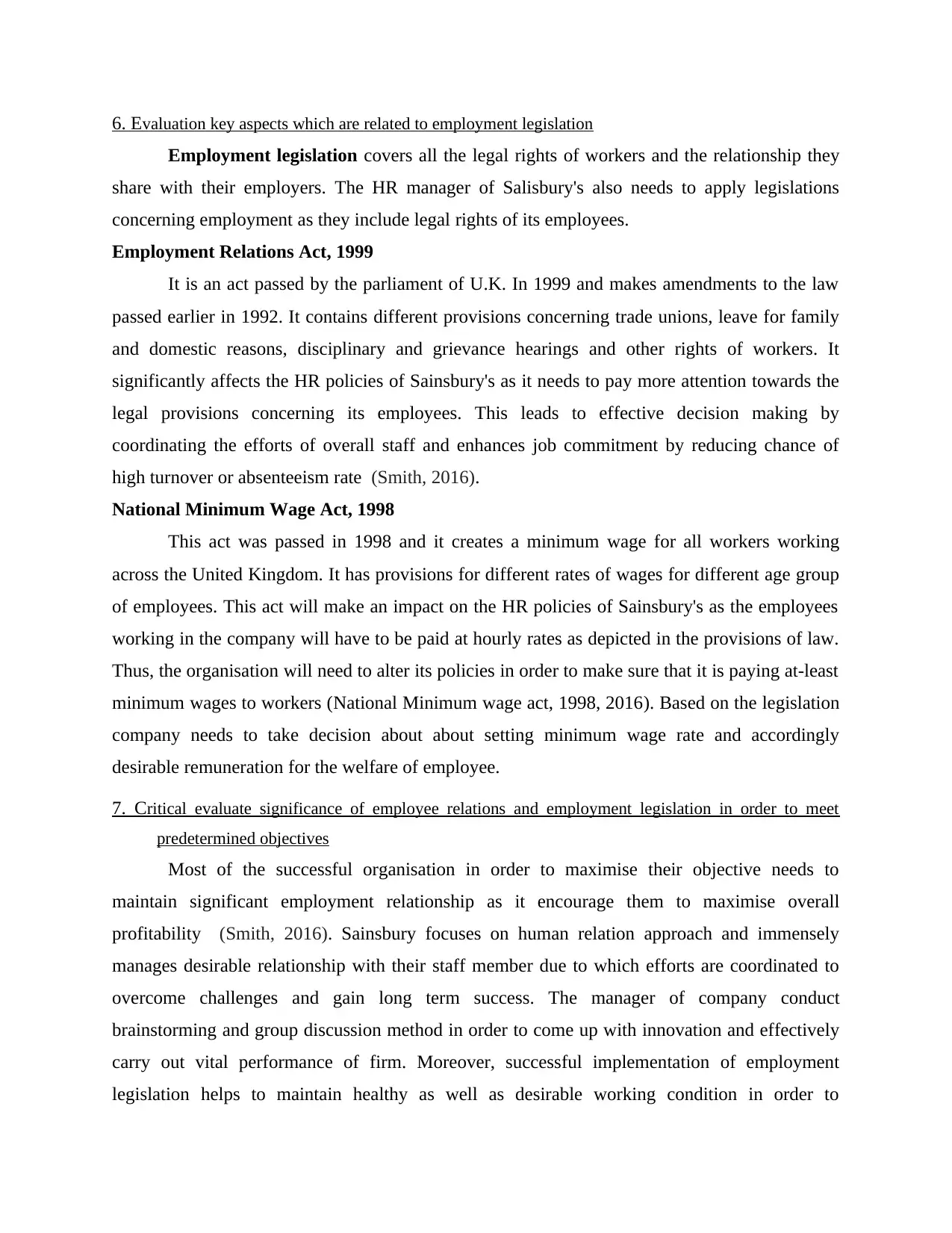
6. Evaluation key aspects which are related to employment legislation
Employment legislation covers all the legal rights of workers and the relationship they
share with their employers. The HR manager of Salisbury's also needs to apply legislations
concerning employment as they include legal rights of its employees.
Employment Relations Act, 1999
It is an act passed by the parliament of U.K. In 1999 and makes amendments to the law
passed earlier in 1992. It contains different provisions concerning trade unions, leave for family
and domestic reasons, disciplinary and grievance hearings and other rights of workers. It
significantly affects the HR policies of Sainsbury's as it needs to pay more attention towards the
legal provisions concerning its employees. This leads to effective decision making by
coordinating the efforts of overall staff and enhances job commitment by reducing chance of
high turnover or absenteeism rate (Smith, 2016).
National Minimum Wage Act, 1998
This act was passed in 1998 and it creates a minimum wage for all workers working
across the United Kingdom. It has provisions for different rates of wages for different age group
of employees. This act will make an impact on the HR policies of Sainsbury's as the employees
working in the company will have to be paid at hourly rates as depicted in the provisions of law.
Thus, the organisation will need to alter its policies in order to make sure that it is paying at-least
minimum wages to workers (National Minimum wage act, 1998, 2016). Based on the legislation
company needs to take decision about about setting minimum wage rate and accordingly
desirable remuneration for the welfare of employee.
7. Critical evaluate significance of employee relations and employment legislation in order to meet
predetermined objectives
Most of the successful organisation in order to maximise their objective needs to
maintain significant employment relationship as it encourage them to maximise overall
profitability (Smith, 2016). Sainsbury focuses on human relation approach and immensely
manages desirable relationship with their staff member due to which efforts are coordinated to
overcome challenges and gain long term success. The manager of company conduct
brainstorming and group discussion method in order to come up with innovation and effectively
carry out vital performance of firm. Moreover, successful implementation of employment
legislation helps to maintain healthy as well as desirable working condition in order to
Employment legislation covers all the legal rights of workers and the relationship they
share with their employers. The HR manager of Salisbury's also needs to apply legislations
concerning employment as they include legal rights of its employees.
Employment Relations Act, 1999
It is an act passed by the parliament of U.K. In 1999 and makes amendments to the law
passed earlier in 1992. It contains different provisions concerning trade unions, leave for family
and domestic reasons, disciplinary and grievance hearings and other rights of workers. It
significantly affects the HR policies of Sainsbury's as it needs to pay more attention towards the
legal provisions concerning its employees. This leads to effective decision making by
coordinating the efforts of overall staff and enhances job commitment by reducing chance of
high turnover or absenteeism rate (Smith, 2016).
National Minimum Wage Act, 1998
This act was passed in 1998 and it creates a minimum wage for all workers working
across the United Kingdom. It has provisions for different rates of wages for different age group
of employees. This act will make an impact on the HR policies of Sainsbury's as the employees
working in the company will have to be paid at hourly rates as depicted in the provisions of law.
Thus, the organisation will need to alter its policies in order to make sure that it is paying at-least
minimum wages to workers (National Minimum wage act, 1998, 2016). Based on the legislation
company needs to take decision about about setting minimum wage rate and accordingly
desirable remuneration for the welfare of employee.
7. Critical evaluate significance of employee relations and employment legislation in order to meet
predetermined objectives
Most of the successful organisation in order to maximise their objective needs to
maintain significant employment relationship as it encourage them to maximise overall
profitability (Smith, 2016). Sainsbury focuses on human relation approach and immensely
manages desirable relationship with their staff member due to which efforts are coordinated to
overcome challenges and gain long term success. The manager of company conduct
brainstorming and group discussion method in order to come up with innovation and effectively
carry out vital performance of firm. Moreover, successful implementation of employment
legislation helps to maintain healthy as well as desirable working condition in order to
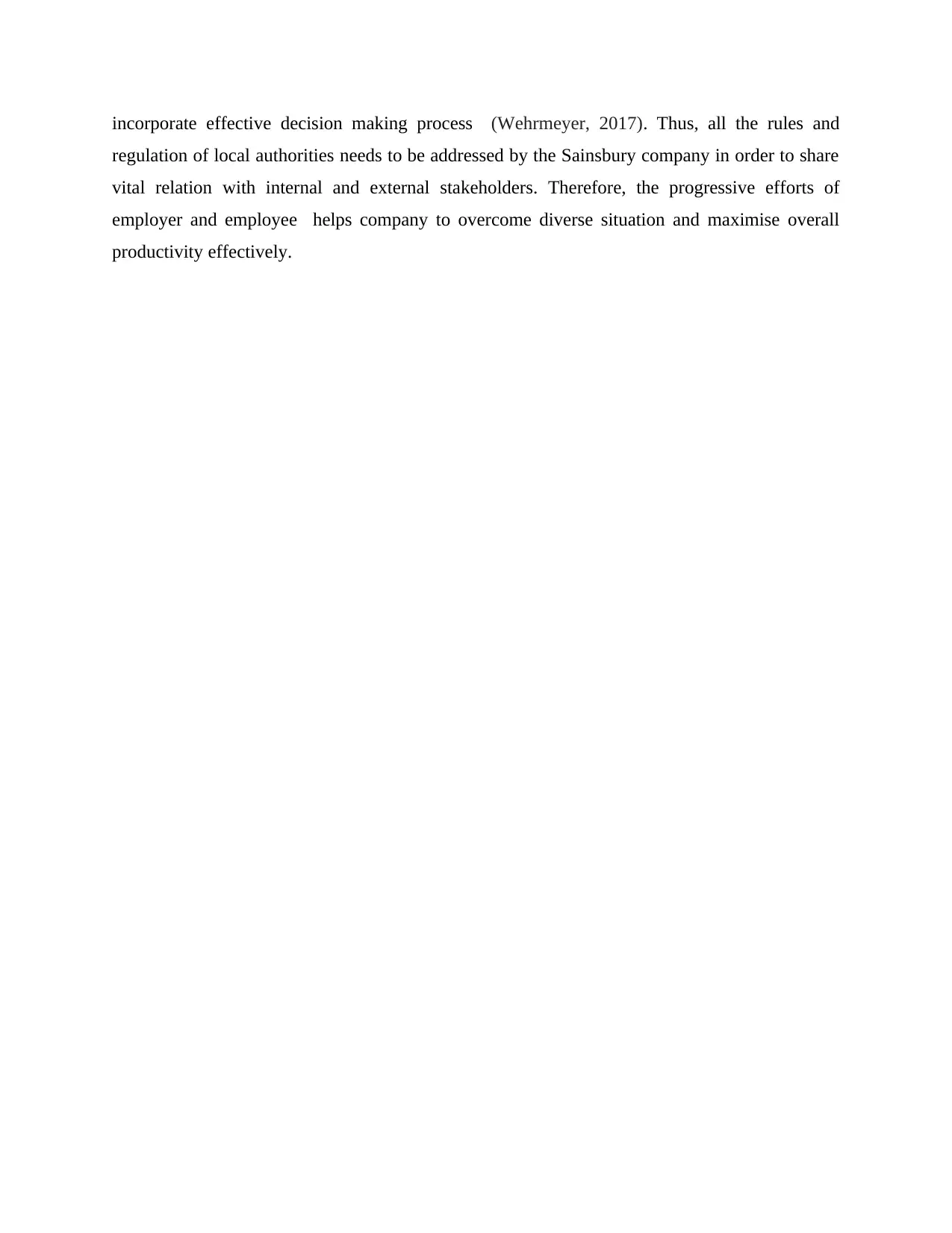
incorporate effective decision making process (Wehrmeyer, 2017). Thus, all the rules and
regulation of local authorities needs to be addressed by the Sainsbury company in order to share
vital relation with internal and external stakeholders. Therefore, the progressive efforts of
employer and employee helps company to overcome diverse situation and maximise overall
productivity effectively.
regulation of local authorities needs to be addressed by the Sainsbury company in order to share
vital relation with internal and external stakeholders. Therefore, the progressive efforts of
employer and employee helps company to overcome diverse situation and maximise overall
productivity effectively.
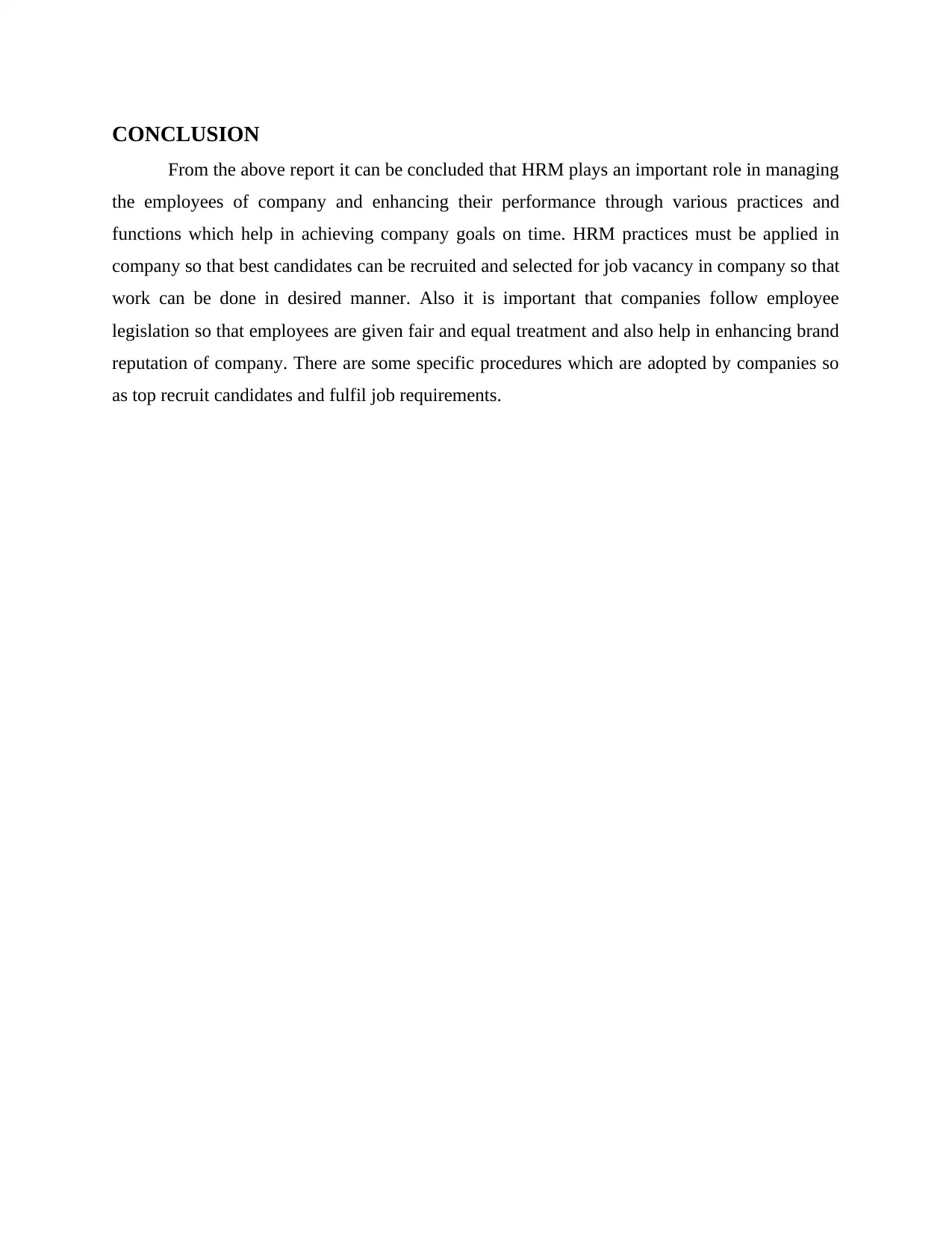
CONCLUSION
From the above report it can be concluded that HRM plays an important role in managing
the employees of company and enhancing their performance through various practices and
functions which help in achieving company goals on time. HRM practices must be applied in
company so that best candidates can be recruited and selected for job vacancy in company so that
work can be done in desired manner. Also it is important that companies follow employee
legislation so that employees are given fair and equal treatment and also help in enhancing brand
reputation of company. There are some specific procedures which are adopted by companies so
as top recruit candidates and fulfil job requirements.
From the above report it can be concluded that HRM plays an important role in managing
the employees of company and enhancing their performance through various practices and
functions which help in achieving company goals on time. HRM practices must be applied in
company so that best candidates can be recruited and selected for job vacancy in company so that
work can be done in desired manner. Also it is important that companies follow employee
legislation so that employees are given fair and equal treatment and also help in enhancing brand
reputation of company. There are some specific procedures which are adopted by companies so
as top recruit candidates and fulfil job requirements.
Paraphrase This Document
Need a fresh take? Get an instant paraphrase of this document with our AI Paraphraser
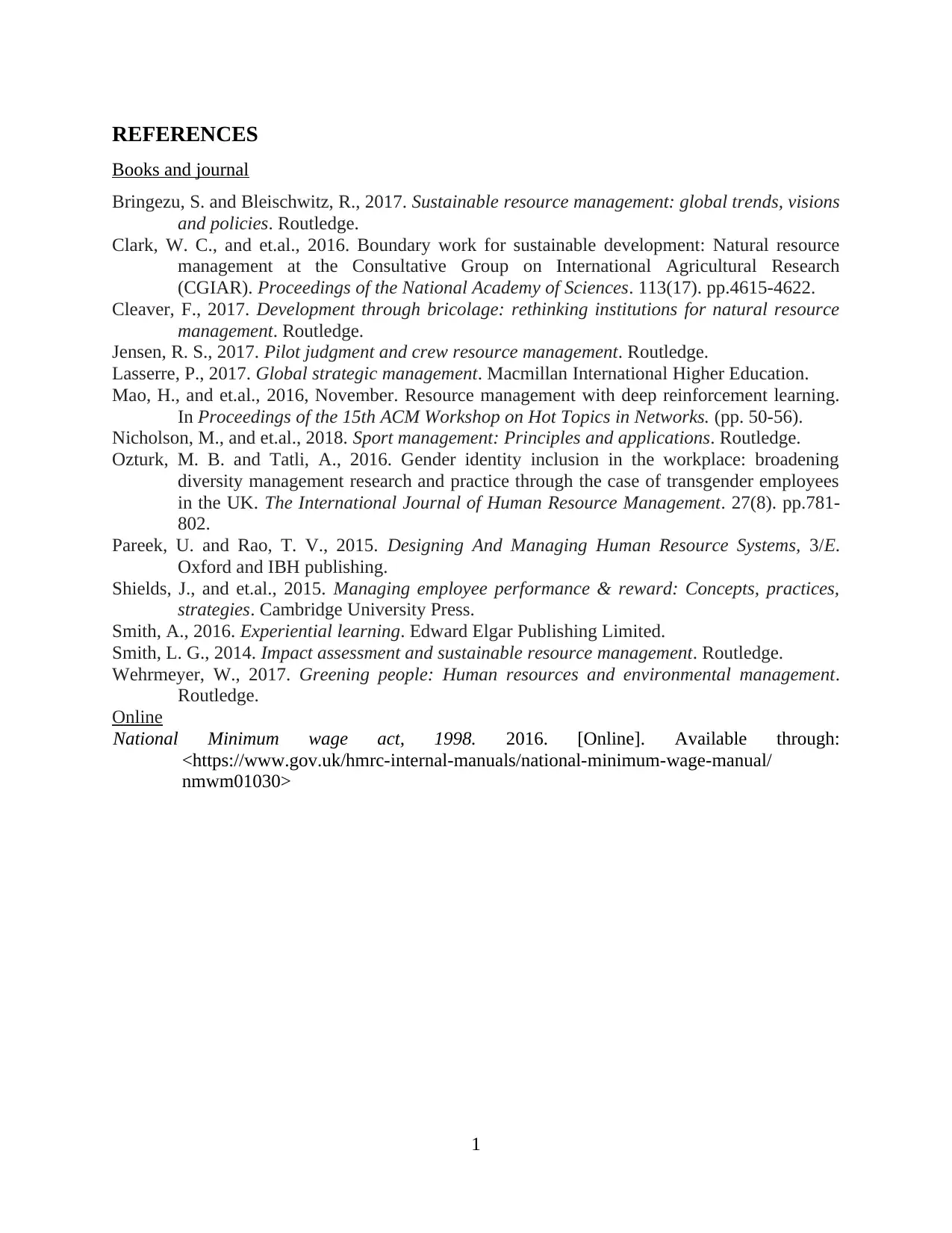
REFERENCES
Books and journal
Bringezu, S. and Bleischwitz, R., 2017. Sustainable resource management: global trends, visions
and policies. Routledge.
Clark, W. C., and et.al., 2016. Boundary work for sustainable development: Natural resource
management at the Consultative Group on International Agricultural Research
(CGIAR). Proceedings of the National Academy of Sciences. 113(17). pp.4615-4622.
Cleaver, F., 2017. Development through bricolage: rethinking institutions for natural resource
management. Routledge.
Jensen, R. S., 2017. Pilot judgment and crew resource management. Routledge.
Lasserre, P., 2017. Global strategic management. Macmillan International Higher Education.
Mao, H., and et.al., 2016, November. Resource management with deep reinforcement learning.
In Proceedings of the 15th ACM Workshop on Hot Topics in Networks. (pp. 50-56).
Nicholson, M., and et.al., 2018. Sport management: Principles and applications. Routledge.
Ozturk, M. B. and Tatli, A., 2016. Gender identity inclusion in the workplace: broadening
diversity management research and practice through the case of transgender employees
in the UK. The International Journal of Human Resource Management. 27(8). pp.781-
802.
Pareek, U. and Rao, T. V., 2015. Designing And Managing Human Resource Systems, 3/E.
Oxford and IBH publishing.
Shields, J., and et.al., 2015. Managing employee performance & reward: Concepts, practices,
strategies. Cambridge University Press.
Smith, A., 2016. Experiential learning. Edward Elgar Publishing Limited.
Smith, L. G., 2014. Impact assessment and sustainable resource management. Routledge.
Wehrmeyer, W., 2017. Greening people: Human resources and environmental management.
Routledge.
Online
National Minimum wage act, 1998. 2016. [Online]. Available through:
<https://www.gov.uk/hmrc-internal-manuals/national-minimum-wage-manual/
nmwm01030>
1
Books and journal
Bringezu, S. and Bleischwitz, R., 2017. Sustainable resource management: global trends, visions
and policies. Routledge.
Clark, W. C., and et.al., 2016. Boundary work for sustainable development: Natural resource
management at the Consultative Group on International Agricultural Research
(CGIAR). Proceedings of the National Academy of Sciences. 113(17). pp.4615-4622.
Cleaver, F., 2017. Development through bricolage: rethinking institutions for natural resource
management. Routledge.
Jensen, R. S., 2017. Pilot judgment and crew resource management. Routledge.
Lasserre, P., 2017. Global strategic management. Macmillan International Higher Education.
Mao, H., and et.al., 2016, November. Resource management with deep reinforcement learning.
In Proceedings of the 15th ACM Workshop on Hot Topics in Networks. (pp. 50-56).
Nicholson, M., and et.al., 2018. Sport management: Principles and applications. Routledge.
Ozturk, M. B. and Tatli, A., 2016. Gender identity inclusion in the workplace: broadening
diversity management research and practice through the case of transgender employees
in the UK. The International Journal of Human Resource Management. 27(8). pp.781-
802.
Pareek, U. and Rao, T. V., 2015. Designing And Managing Human Resource Systems, 3/E.
Oxford and IBH publishing.
Shields, J., and et.al., 2015. Managing employee performance & reward: Concepts, practices,
strategies. Cambridge University Press.
Smith, A., 2016. Experiential learning. Edward Elgar Publishing Limited.
Smith, L. G., 2014. Impact assessment and sustainable resource management. Routledge.
Wehrmeyer, W., 2017. Greening people: Human resources and environmental management.
Routledge.
Online
National Minimum wage act, 1998. 2016. [Online]. Available through:
<https://www.gov.uk/hmrc-internal-manuals/national-minimum-wage-manual/
nmwm01030>
1
1 out of 14
Related Documents
Your All-in-One AI-Powered Toolkit for Academic Success.
+13062052269
info@desklib.com
Available 24*7 on WhatsApp / Email
![[object Object]](/_next/static/media/star-bottom.7253800d.svg)
Unlock your academic potential
© 2024 | Zucol Services PVT LTD | All rights reserved.





